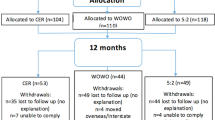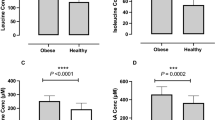Abstract
Objective: To examine changes in plasma lipids and lipoproteins after 51 months of reduced energy intake and sustained weight loss.
Methods: One-hundred patients were randomized to one of two dietary interventions for 3 months (weight loss period). Groups A and B received an energy-restricted diet plan of 5.2–6.3 MJ/day but group B was further instructed to replace two of three meals with a nutrient-fortified liquid meal replacement (MR). Upon completion of the weight loss period, all patients were given the same instructions regarding energy intake and were advised to use one MR daily. Body weight and 7 day food diaries were measured monthly or bimonthly and blood lipids at baseline, 3, 9 and 51 months.
Results: Of the original 100 patients 75 had completed 4 y. Of those 75, 73 had complete lipid records. Baseline body weights of Groups A and B were 90.7±14.0 and 91.6±9.8 kg, respectively. The percentage change in total cholesterol (%ΔTC) decreased in a linear fashion with increasing weight loss, when all data was combined, but did not approach statistical significance (P≤0.26, r=0.02). Further regression analysis found a significant negative linear relationship (P≤0.0001, r=0.69) between initial total cholesterol (TC) concentrations and %ΔTC. Hence, data from 27 of the 73 completers who exhibited an elevated serum total cholesterol (≥6.2 mmol/l) were isolated and analyzed further. Baseline TC was 6.75±0.64, 5.85±0.63 at 9 months (P<0.05) and 5.76±0.52 mmol/l at 51 months (P<0.05). Similar values for VLDL-cholesterol were 1.33±0.80, 0.74±0.24 and 0.66±0.21 mmol/l by 51 months (P<0.05). Weight decreased by 5.2±5.1, 7.6±4.9 and 6.7±4.6% at 3, 9 and 51 months, respectively.
Conclusion: Continuous energy restriction associated with a clinically meaningful weight loss significantly improved the lipid profile of high-risk patients. Similar weight and diet changes occurring in patients with normal plasma cholesterol were either increased or without affect.
This is a preview of subscription content, access via your institution
Access options
Subscribe to this journal
Receive 12 print issues and online access
$259.00 per year
only $21.58 per issue
Buy this article
- Purchase on Springer Link
- Instant access to full article PDF
Prices may be subject to local taxes which are calculated during checkout

Similar content being viewed by others
References
Blackburn GL . 1995 Effect of degree of weight loss on health benefits Obes. Res. 3: 211S–216S
Dattilo AM, Kris-Etherton PM . 1992 Effects of weight reduction on blood lipids and lipoproteins: a meta-analysis Am. J. Clin. Nutr. 56: 320–328
Denke MA, Sempos CT, Grundy SM . 1993 Excess body weight. An underrecognized contributor to high blood cholesterol levels in white American men Arch. Intern. Med. 153: 1093–1103
Eckel RH . 1999 The importance of timing and accurate interpretation of the benefits of weight reduction on plasma lipids Obes. Res. 7: 227–228
Elashoff RM, Johnson TD, Winters BL, Yun C . 1999 Modern statistical regression methods for a longitudinal dietary intervention feasibility study In Nutritional Oncology, eds. D Heber, GL Blackburn, VLW Go, Chap 45. San Diego, CA: Academic Press
Flechtner-Mors M, Ditschuneit HH, Johnson TD, Suchard MA, Adler G . 2000 Metabolic and weight-loss effects of a long-term dietary intervention in obese patients. Four-year results Obes. Res. 8: 399–402
Flynn MM, Zmuda JM, Milosavljevic D, Caldwell MJ, Herbert PN . 1999 Lipoprotein response to a National Cholesterol Education Program Step II diet with and without energy restriction Metabolism 48: 822–826
Friedewald WT, Levy RI, Fredrickson DS . 1972 Estimation of the concentration of low-density lipoprotein cholesterol in plasma, without the use of the preparative ultracentrifuge Clin. Chem. 18: 449–502
Lichtenstein AH, Ausman LM, Carrasco W, Jenner JL, Ordovas JM, Schaefer EJ . 1994 Short-term consumption of a low-fat diet beneficially affects plasma lipid concentrations only when accompanied by weight loss Arterioscler. Thromb. 14: 1751–1760
National Heart, Lung, and Blood Institute NIH . 1998 Clinical Guidelines on the identification, evaluation, and treatment of overweight and obesity in adults Obes. Res. 6 Suppl 2: 51S–180S
NCEP . 1993 Summary of the Second Report of the National Cholesterol, Education Program (NCEP) Expert Panel on Detection, Evaluation, and Treatment of High Cholesterol in Adults (Adult Treatment Panel II) J.A.M.A. 269: 3015–3023
Pi-Sunyer FX . 1993 Short-term medical benefits and adverse effects of weight loss Am. Coll. Phys. 119: 722–726
Pi-Sunyer FX . 1996 A review of long-term studies evaluating the efficacy of weight loss in ameliorating disorders associated with obesity Clin. Ther. 18: 1006–1035
Sjöström DC, Lissner L, Wedel H, Sjöström L . 1999 Reduction in incidence of diabetes, hypertension and lipid disturbances after intentional weight loss induced by bariatric surgery: the SOS Intervention Study Obes. Res. 7: 477–484
Snedecor GW, Cochran WG . 1967 Statistical Methods, 6th ed, Chapter 6. Iowa: Iowa State University Press
Van Gaal LF, Wauters MA, De Leeuw IH . 1997 The beneficial effects of modest weight loss on cardiovascular risk factors Int. J. Obes. Relat. Metab. Disord. 21: S5–S9
Wadden TA, Anderson DA, Foster GD . 1999 Two-year changes in lipids and lipoproteins associated with the maintenance of a 5% to 10% reduction in initial weight: some findings and some questions Obes. Res. 7: 170–178
Weinsier RL, James LD, Darnell BE, Wooldridge NH, Birch R, Hunter GR, Bartolucci AA . 1992 Lipid and insulin concentrations in obese postmenopausal women: separate effects of energy restriction and weight loss Am. J. Clin. Nutr. 56: 44–49
Yu-Poth S, Zhoa G, Etherton T, Naglak M, Jonnalagadda S, Kris-Etherton PM . 1999 Effects of the National Cholesterol Education Program's Step I and Step II dietary intervention programs on cardiovascular disease risk factors: a meta-analysis Am. J. Clin. Nutr. 69: 632–646
Acknowledgements
We thank Katja Huber (research laboratory of the Department of Medicine, University of Ulm, Ulm, Germany) for her technical assistance. We thank Richard Deckelbaum, MD, PhD (Columbia University, College of Physicians and Surgeons, New York, NY, USA) for assistance with the data analysis and fruitful discussions. We thank the Slim-Fast Foods Company (West Palm Beach, FL, USA) for providing the diet shakes and nutrition bars for use in this study.
Author information
Authors and Affiliations
Corresponding author
Rights and permissions
About this article
Cite this article
Ditschuneit, H., Frier, H. & Flechtner-Mors, M. Lipoprotein responses to weight loss and weight maintenance in high-risk obese subjects. Eur J Clin Nutr 56, 264–270 (2002). https://doi.org/10.1038/sj.ejcn.1601375
Received:
Revised:
Accepted:
Published:
Issue Date:
DOI: https://doi.org/10.1038/sj.ejcn.1601375
Keywords
This article is cited by
-
Pharmacotherapy of Obesity: Limits and Perspectives
American Journal of Cardiovascular Drugs (2019)
-
Randomized Placebo‐Controlled Clinical Trial of Lorcaserin for Weight Loss in Type 2 Diabetes Mellitus: The BLOOM‐DM Study
Obesity (2012)
-
Evaluation of the Abuse Potential of Lorcaserin, a Serotonin 2C (5-HT2C) Receptor Agonist, in Recreational Polydrug Users
Clinical Pharmacology & Therapeutics (2011)
-
Effect of a low-calorie high nutritional value formula on weight loss in type 2 diabetes mellitus
Mediterranean Journal of Nutrition and Metabolism (2010)
-
Industry funding and the reporting quality of large long-term weight loss trials
International Journal of Obesity (2008)



